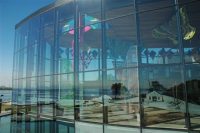Asia
Cambodia

The National Kite Museum of Phnom Penh, Cambodia, houses many examples of the varied Cambodian kite designs. The collection includes tools, materials, and biographical information as well as historical information.
China
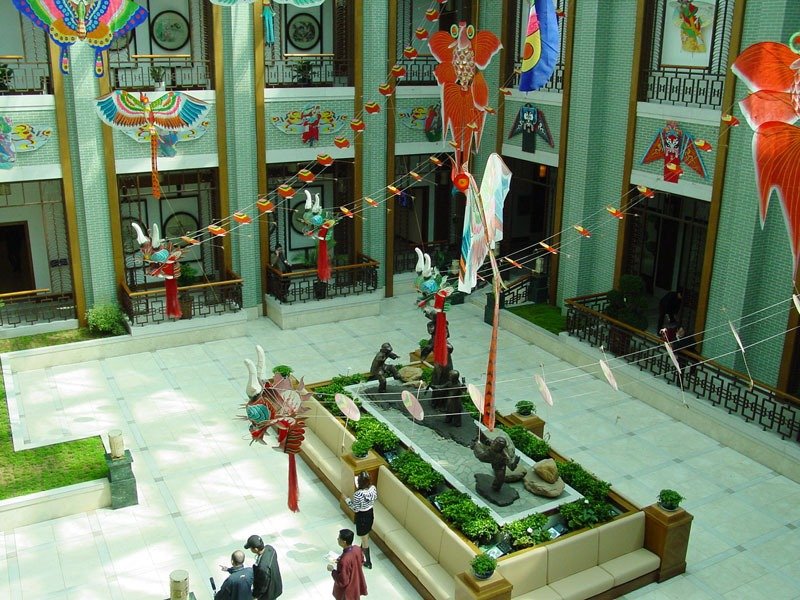
Weifang Kite Museum, Weifong, China
Situated in the city of Weifang, Shandong Province, and built in 1987, Weifang Kite Museum is China’s first official museum displaying various kinds of kites. The whole museum is twelve thousand square meters with a floor space of 8100 square meters. The museum consists of twelve exhibition halls of different sizes. A superb collection of kites is on display, the oldest kite being the “Luban kite” of the 5th century BCE.
More information here (website in Chinese).
India
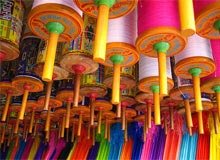
The Kite Museum Ahmedabad, located in Sanskar Kendra, Gujarat Province, India houses the collection of Bhanubhai Shah. Shah’s curated collection of kites from around the world focuses on the fighter kites of India.
Indonesia

Museum Layang Layang
This is the first museum featuring kites in Indonesia and was opened to the public in February 2002 during the 7th International Kite Festival. Museum displays include collections of kites from all corners of Nusantara, as well as other countries, and includes both traditional and modern kites.
Japan

Tokyo Kite Museum, Tokyo, Japan.
Directed by Masaaki Modegi, president of the Japan Kite Association. This collection consists of Japanese kites from the early 20th Century to the present and also includes prime examples of kites from around the world. In 1997 the museum collaborated with the Drachen Foundation to produce the full-color book Kites: Paper Wings Over Japan (Thames and Hudson: New York 1997).
More information here (website in Japanese).

Hamamatsu Festival Hall
Hamamatsu Festival, held annually from May 3 – 5, is well-known for Takoage Gassen, the kite fight, and luxuriously decorated dashi, luxuriously decorated palace-like floats. The festival hall contains a a small dashi. It also contains many of the city’s Machijirushi kites and good information about the annual kite battle, which originated over 430 years ago when the lord of Hamamatsu Castle celebrated the birth of his first son by flying kites. Japanese kites from the entire country round out the display at the Hamamatsu Festival Hall.

Ikazaki Kite Museum
Ikazaki, Ehime Prefecture, Japan
This is a new museum, with kites from Japan and foreign countries and wonderful historical photos of the Ikazaki Kite Festival. The museum also includes kites that are used in the giant kite battle, in which flyers attempt to cut down the kites of other competitors with special line cutters. Ikazaki is also famous for the three kinds of high-quality paper made there, and a traditional papermaker has a workshop near the museum that is well worth visiting.
More information here.

Shirone Odako to Rekishinoyakata
Shiron, Japan
A new museum, this large, beautiful building holds full-size Shirone kites, an extensive collection of well-labeled Japanese kites, and many unique foreign examples. The building even has a wind tunnel for kite testing. Of course, it houses many beautiful Shirone giant kites.
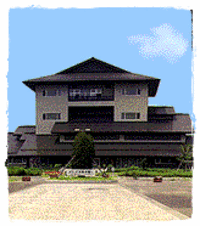
Showamachi Odako Kaikan
Showamachi, Japan
Four full-size Showamachi odako are the highlight of this museum. The museum also contains some foreign examples, and displays over 450 types of kites.

Yokaichi World Kite Museum
Yokaichi, Shiga Prefecture, Japan
This museum features the unique Yokaichi odako. Visitors can also observe the process of making a giant kite at the museum during their visit. The annual festival is held on the fourth Sunday of May. This is a region of Japan where paper making is still practiced in the traditional manner, which is well worth exploring.
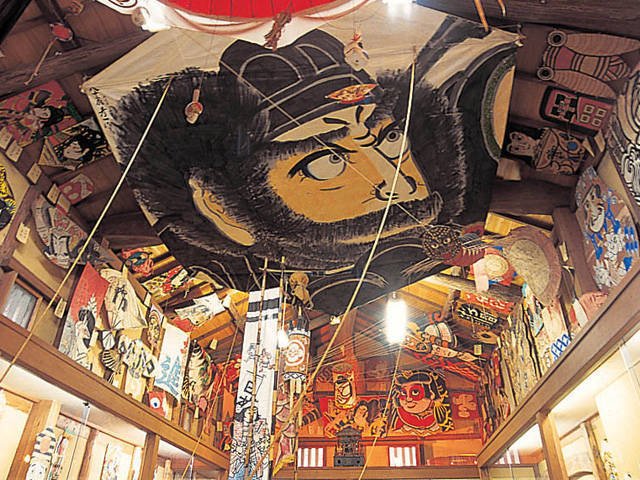
The Toy Museum Kurashiki
Kurashiki, Japan
A private collection, curated by Mr. Ooga, holds more than two hundred Japanese kites, surveying the kites of all regions of Japan. Like those in the Tokyo Kite Museum, there are many antique examples. These kites are displayed among the most wonderful traditional Japanese toys, of which the museum has over 40,000.
More information here.
Malaysia

Malaysian Kite Museum (Pasir Gudang Kite Museum)
Pasir Gudang, Malaysia
This museum displays several hundred kites in a relatively small, three-level display space, and also includes a collection of ceramic vases. More than three hundred waus from all thirteen states of Malaysia, and two hundred kites from elsewhere in the world, are featured. Also, displayed among the masterpiece examples of waus are kitemaking materials, tools, techniques, memorabilia such as photographs, pins, ceramics, stamps and posters. The gift shop and library are accessible to all visitors, and a wau making workshop guides visitors through the process of making a Malaysian wau.
More information here.

The Kite Museum
Jalan Kota, Bandar Melaka, Melaka, Malaysia
This museum is located on the fourth floor of the building housing the People’s Museum in Jalan Kota, Bandar Hilir Melaka. It was opened by the Chief Minister of Melaka in September 1995. The museum displays kites, both traditional and modern, as well as the history of kites as communication tools, in war, or simply for leisure. Kites from China, India, New Zealand and Australia are also featured.
More information here.
Taiwan
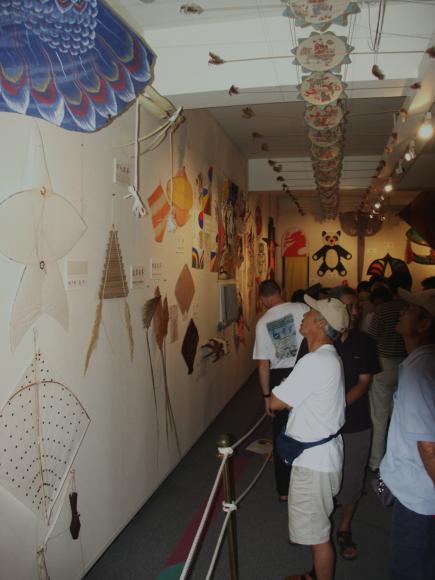
Kite Museum of Chiou Fen (Jioufen)
Chiou Fen, Taiwan
This is a glorious private collection of kites, is located in an old building in the deserted gold mine town of Chiou Fen. The building houses the kites in the lower floors, with hotel accommodations and dining in the upper levels.
Europe
The Museum of Kites
Middleton, Teesdale, United Kingdom
A vast collection of kites from all over the world, curated by Malcolm Goodman, is housed in a charming old bed-and-breakfast.
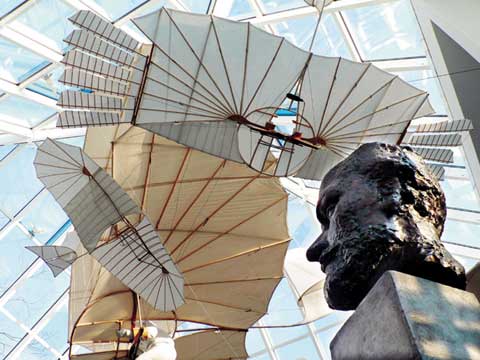
The Otto Lilienthal Museum
Anklam, Germany
In 1891, the German civil engineer Otto Lilienthal succeeded in achieving the first safe, multiple gliding flights in history. Lilienthal’s experiments and scientific approaches were adopted by the Wright Brothers (USA) for their quest to develop a controllable, self-propelled flying machine. The Otto Lilienthal Museum was opened on the 100th anniversary of Lilienthal’s first flight in Anklam, the city of his birth.
More information here.
North America
The Kite Museum
Pelee Island, Canada
The Paisiovich family has amassed a large collection of kites, mostly European and North American examples. The collection includes contemporary artistic and festival kites as well as fine historical examples. The museum is an active promoter of kites through workshops and traveling exhibits. The museum is located on Pelee Island, Canada, in the middle of Lake Erie, and was developed partially as a way to promote tourism to an island that is so well suited to kite flying.
More information here.

Blue Hill Observatory
Milton, Massachusetts
The early history of scientific kites – especuakkt those used for meteorology – can be discovered in the Blue Hill Observatory’s collection. Tours of the facility show where and how kites were flown and the Observatory library contains significant information pertaining to kites.
More information here.

World Kite Museum
Long Beach, Washington
Housing the United States’ largest collection of traditional and contemporary kites, the WKM collection houses Japanese and Chinese kites from the Dave Checkley collection and contemporary donations from visitors from around the world.
The Drachen Foundation has collaborated in organizing several of the museum’s exhibits and has arranged donations to the Museum, such as the archives of the American Kitefliers Association.
More information here.



